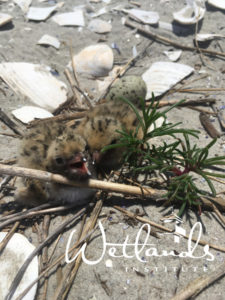This was a tough winter with bitter cold and a long hard freeze of the marsh and tidal channels. As I write this, its mid-February and already the first early birds have returned to the marsh. As with every year, these early arrivals are our benchmark, and pretty much like clockwork, we realize we have so much more to do before spring is fully upon us.
The winter is our time to plan, evaluate and write. We spruced up the admissions and Tidepool areas with a pretty major face lift. We are in the process of reviewing applications for all the spring and summer seasonal positions and intern programs. The Education department has been busy evaluating programs and revising and adding exciting new activities, while they continue to deliver school programs. The Research and Conservation department has been hard at work finishing several grant projects and analyzing data to contribute to management decisions. We have been working quite a bit on beneficial use projects for marsh restoration and contributing to numerous reports and analyses. I believe this is an important area of work we are doing and one that has the potential to really help drive wetland restoration decisions for the next decade. By combining our work monitoring the wetlands around the Institute, with our work designing and evaluating marsh, beach and habitat restoration projects, we are building a very strong knowledge base and helping to guide thinking and actions in the next phase of work in this seminal area.

We have been fortunate to be working closely with the US Army Corp of Engineers on the design and monitoring of bird nesting habitats being constructed with dredge material. This winter two new projects were constructed and we contributed to the site designs using the lessons we have learned so far. We will be monitoring these sites for the next few years. At the end of January, I was invited to deliver a keynote address to a regional wetlands conference. I used the opportunity to challenge the wetland restoration community to think more broadly and to be more vigilant of the needs of the marshes and their inhabitants as we all try to build more resilient coastal communities.
As the weather warms, the marsh will awaken, and we will be continuing our work to ensure these marshes are here for generations to come, that they are teeming with life, and all of you have ample opportunity to experience the wonders of these remarkable ecosystems. Come visit and renew your connections.
